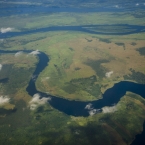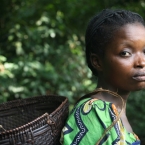Grand Inga Dam, DR Congo
Grand Inga, the world’s largest hydropower scheme, is proposed for the Congo River in the Democratic Republic of Congo (DRC), one of Africa’s most politically volatile and corruption-plagued countries. The massive dam is part of a greater vision by the international economic community to develop a power grid across Africa that will spur the continent's industrial economic development. But with a price tag of US$80 billion, concerns are growing that foreign companies will gain vast economic benefits from this mega-project, taking attention away from the development needs of Africa’s poor majority.
Grand Inga could produce up to 40,000 MW of electricity, over twice the power generation of Three Gorges Dam in China, and more than a third of the total electricity currently produced in Africa. The Grand Inga is a series of dams that are proposed for the lower Congo River in the democratic Republic of the Congo (DRC.) The Grand Inga will be constructed in seven phases of which Inga 3 BC Dam is the first phase. The project is already being touted as a way to "light Africa" by companies that stand to benefit from it and governments that hope to receive power from it. Grand Inga is listed as a priority project of the Southern Africa Development Community (SADC), the New Partnership for African Development (NEPAD), South African Power Pool (SAPP) and the World Energy Council.
There are advanced plans to construct Inga 3 BC (4,800 MW) for export to South Africa and to cater to mining companies in the southeast of DRC. A treaty was signed in May 2013 by the South African and DRC governments for cooperation in the development of Inga 3 as well as making South Africa the Principal purchaser of the electricity that will be generated. The treaty was ratified in 2014 by DRC.
Where are the Inga Dams located?
The Inga dams are located in western Democratic Republic of the Congo, 150 km upstream of the mouth of the Congo River, and 225 km (140 miles) southwest of Kinshasa on the Congo River. The Congo River is the world’s second largest in terms of flow (42,000m3/s), after the Amazon, and the second longest river in Africa (4,700km), after the Nile River. It empties into the equatorial Atlantic Ocean creating what is famously known as the Congo Plume. The plume is a high-productivity area arising from the rich nutrient flow from the river and is detected as far as 800km offshore. The plume accounts for 40-80% of total carbon productivity and is one of the largest carbon sinks in the world.
The river is unique in that it has large rapids and waterfalls very close to the mouth while most rivers have these features upstream. The dam site is on the largest waterfall in the world by volume, the Inga Falls. Inga Falls is a series of falls and rapids that drop in elevation via small rapids. The main falls are 4 km wide, dropping to about 21.37 metres near a bend and forming hundreds of channels and rivulets and many small islands. At the Grand Inga site the Congo River drops 96 meters in a run of 14.5 km.
The falls are currently incorporated into the Inga 1 and Inga 2 hydroelectric facilities. The volume of the river diverted for Inga 1 and 2 is approximately 30% of the average discharge. It is postulated that if the Grand Inga project is built, it will draw as much as two-thirds of the river water, if not more.
Design
Based on a feasibility study conducted by AECOM-EdF from 2011 to 2013, Grand Inga would be constructed in seven development phases with Inga 3 BC being the first of these phases. Inga 3 would be constructed in two steps, initially a low head and then a high head, extending the dam wall and making it higher. There would be no closure of the Congo River and no tunnels, just an open channel. About 6,000m3 m/s would be diverted for Inga 3 to a valley which runs parrallel to the Congo riverbed. If completed, Inga 3 BC would produce 4,800MW of electricity.
Further stages would necessitate the flooding of the Bundi Valley to form a 22,000-hectare reservoir, drowning the Inga 3 channel. The lastest design approach allows the development of Grand Inga to have independent phases that could be operated by different operators.
Financing
Potential contributors are the African Development Bank (AfDB) and the European Investment Bank. In 2014, the World Bank approved a US$73.1 million grant to support the technical aspect of Inga 3 BC, in 2016 the bank cancelled its support to the project. The Bank's technical support was meant to cover EIA and technical studies. The AfDB has provided $15 million dollars since 2010 to conduct a feasibility study of both the Grand Inga and Inga 3 hydro projects. The study was undertaken by a Canadian/French consortium. In Marrakech in June 2013, the AfDB and the DRC government signed two grant agreements for a total of $5.25 million. These grants fall within the framework of the Fragile State Facility (FSF) and are intended to provide technical assistance for the development of Inga. Grand Inga will be financed under a Public/Private partnership structure and is listed by the G20-Multilateral Development Banks as one of the top 10 “Exemplary Transformational Projects” that is large projects meant to have a significant impact on development. The strategy is to source financing from both private and public sources and fund the project through a Private Public Partnership model.
Why is Grand Inga being proposed?
Africa faces a huge energy gap that has contributed to slow economic development and poverty. On the other hand, Africa has a huge potential for all forms of energy – hydropower, solar, wind and fossil fuel energy. The proponents of the Grand Inga project (mainly African governments and development organizations) consider hydropower to be clean renewable energy.
They have put forward arguments that the Grand Inga hydropower scheme will provide cheaper and readily available energy and allow Africa’s industrial and manufacturing industry to take off. In addition, the project is promoted as being good for promoting peace in the region and for the environment. However, a number of concerns that include environmental and social impacts of this project have not yet been addressed and all energy options are still to be explored.
What is the current status of the project?
South Africa and the DRC signed a Memorandum of Understanding (MOU) in November 2011 for the development of Grand Inga. So far three feasibility studies for the Grand Inga have been done, with the latest having been carried out in 2009. In May 2013, the two governments signed a co-operation Treaty to jointly develop the Inga 3 Dam, and the treaty was ratified by DRC in 2014. South Africa would purchase 2,500 MW of the total 4,800 MW generated, making it the principal buyer for Inga 3 electricity. Following the signing of the treaty, the DRC relaunched the process for the selection of a developer and established the first stage objective of the Inga dam – to lay the foundation stone in October 2015. In March 2015, the World Bank announced that construction work of Inga 3 BC won't begin until 2017 at the earliest. A number of consortia including Sinohydro, the Three Gorges Corporation from China, Actividades de Construcion y Servicios (ACS), Eurofinsa and AEE from Spain are currently bidding for selection as developers of the Grand Inga. The Terms of Reference for the Socio and Environmental Impact Studies (SEIA) for Inga 3 were posted in early July 2013 for public comments. These studies have not yet been concluded and construction is planned to commence in 2017. The feasibility study report was presented to the public in September, 2013 in Kinshasa.
What are the likely negative impacts of the dam?
The Grand Inga is a massive project that will require huge sums of money for its realization and astute management for tendering process and implementation. Based on history there are high risks of corrupt deals and ever-escalating costs. Because of its unique ecological systems, huge ecological impacts that include nutrient and sediment trapping and loss of the mid-Atlantic plume are anticipated. Diverting the flow of the Congo river to create a reservoir would flood the Bundi Valley, affecting local agricultural lands and natural environments, and may cause huge methane emissions that would contribute to global warming. The effect of a reduced flow in the Congo River may cause loss of biodiversity and a shift in the dominant species. The flooded area may also create an environment that is conducive for the breeding of water-borne vectors such as the malanquin mosquito.
Transmission lines always result in huge corridors of forests being cleared. The DRC has the worlds’ second-largest rainforest and loss of the forest to create paths for electricity transmission lines would have significant environmental and social impacts, not to mention the security and maintenance risks posed by such a long transmission system.
Very little of the electricity generated by Grand Inga would provide for city- or village-level power to Congolese people. There are claims that the power would uplift the DRC, but so far there is no strategy to show how poor communities would access the electricity.
Our Concerns
Our concerns are that 91% of the people in DRC have no electricity and yet the continent’s biggest infrastructure investment would all be for the extractive industries and far-away urban centers. We are further troubled by the impacts the dam would have on sediment transportation and biogeochemical processes in the Atlantic, possible carbon emissions from the reservoir and largely the socioeconomic impacts. The socioeconomic impacts include impacts on the people living in the area that would be inundated and the cost-benefit for the poor people of the DRC, especially in terms of debt burden and access to modern electricity. The DRC needs to subject the Grand Inga proposal to the World Commission on Dams standards.
The nearby Inga 1 and 2 Dams are undergoing a major rehabilitation with financial assistance from the World Bank, European Investment Bank and African Development Bank. Inga 2 is also undergoing rehabilitation through a partial privatization scheme with a little-known company, MagEnergy, and financial support from South Africa's Industrial Development Corporation. Inga's displaced communities have been struggling since the 1960s to obtain fair compensation and have received nothing to date. The poor maintenance and financial problems of Inga 1 and 2 raise concerns about the operational risks of Inga 3 and Grand Inga.
Corruption is prevalent in the DRC and huge infrastructure are prone to corruption. Most large infrastracture whose construction stretches over years have been known to incur huge cost overruns. Many people consider US$80 billion for the Grand Inga as an underestimate. We wonder what the full cost would be.







